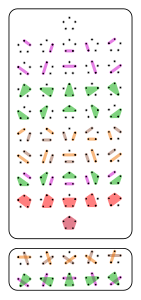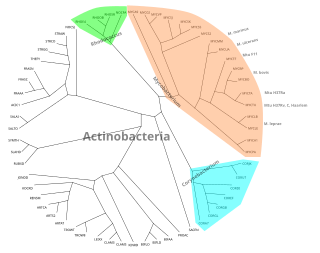Combinatorics is an area of mathematics primarily concerned with counting, both as a means and an end in obtaining results, and certain properties of finite structures. It is closely related to many other areas of mathematics and has many applications ranging from logic to statistical physics, from evolutionary biology to computer science, etc.

In mathematics, an isomorphism is a homomorphism or morphism that can be reversed by an inverse morphism. Two mathematical objects are isomorphic if an isomorphism exists between them. An automorphism is an isomorphism whose source and target coincide. The interest of isomorphisms lies in the fact that two isomorphic objects cannot be distinguished by using only the properties used to define morphisms; thus isomorphic objects may be considered the same as long as one considers only these properties and their consequences.

In combinatorial mathematics, the Catalan numbers form a sequence of natural numbers that occur in various counting problems, often involving recursively-defined objects. They are named after the Belgian mathematician Eugène Charles Catalan (1814–1894).

In graph theory, an isomorphism of graphsG and H is a bijection between the vertex sets of G and H
Combinatorics is a branch of mathematics concerning the study of finite or countable discrete structures.
Discrete mathematics is the study of mathematical structures that are fundamentally discrete rather than continuous. In contrast to real numbers that have the property of varying "smoothly", the objects studied in discrete mathematics – such as integers, graphs, and statements in logic – do not vary smoothly in this way, but have distinct, separated values. Discrete mathematics therefore excludes topics in "continuous mathematics" such as calculus and analysis.
In mathematics, the term combinatorial proof is often used to mean either of two types of mathematical proof:
In combinatorics, especially in analytic combinatorics, the symbolic method is a technique for counting combinatorial objects. It uses the internal structure of the objects to derive formulas for their generating functions. The method is mostly associated with Philippe Flajolet and is detailed in Part A of his book with Robert Sedgewick, Analytic Combinatorics. Similar languages for specifying combinatorial classes and their generating functions are found in work by Bender and Goldman, Foata and Schützenberger, and Joyal. The presentation in this article borrows somewhat from Joyal's combinatorial species.

In graph theory, a graph property or graph invariant is a property of graphs that depends only on the abstract structure, not on graph representations such as particular labellings or drawings of the graph.
In combinatorics, the twelvefold way is a systematic classification of 12 related enumerative problems concerning two finite sets, which include the classical problems of counting permutations, combinations, multisets, and partitions either of a set or of a number. The idea of the classification is credited to Gian-Carlo Rota, and the name was suggested by Joel Spencer.

In Euclidean plane geometry, a pseudotriangle (pseudo-triangle) is the simply connected subset of the plane that lies between any three mutually tangent convex sets. A pseudotriangulation (pseudo-triangulations) is a partition of a region of the plane into pseudotriangles, and a pointed pseudotriangulation is a pseudotriangulation in which at each vertex the incident edges span an angle of less than π.

In computer science and discrete mathematics, a sequence has an inversion where two of its elements are out of their natural order.
In the mathematical field of order theory an order isomorphism is a special kind of monotone function that constitutes a suitable notion of isomorphism for partially ordered sets (posets). Whenever two posets are order isomorphic, they can be considered to be "essentially the same" in the sense that one of the orders can be obtained from the other just by renaming of elements. Two strictly weaker notions that relate to order isomorphisms are order embeddings and Galois connections.

In number theory, the Schröder–Hipparchus numbers form an integer sequence that can be used to count the number of plane trees with a given set of leaves, the number of ways of inserting parentheses into a sequence, and the number of ways of dissecting a convex polygon into smaller polygons by inserting diagonals. These numbers begin

In mathematics, the telephone numbers or the involution numbers are a sequence of integers that count the ways n telephone lines can be connected to each other, where each line can be connected to at most one other line. These numbers also describe the number of matchings of a complete graph on n vertices, the number of permutations on n elements that are involutions, the sum of absolute values of coefficients of the Hermite polynomials, the number of standard Young tableaux with n cells, and the sum of the degrees of the irreducible representations of the symmetric group. Involution numbers were first studied in 1800 by Heinrich August Rothe, who gave a recurrence equation by which they may be calculated, giving the values
In mathematics, equivalent definitions are used in two somewhat different ways. First, within a particular mathematical theory, a notion may have more than one definition. These definitions are equivalent in the context of a given mathematical structure. Second, a mathematical structure may have more than one definition.
Mireille Bousquet-Mélou is a French mathematician who specializes in enumerative combinatorics and who works as a senior researcher for the Centre national de la recherche scientifique (CNRS) at the computer science department (LaBRI) of the University of Bordeaux.










